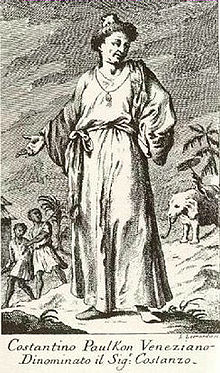Constantine Phaulkon
Constantine Phaulkon (aka Konstantin Gerakis , Κωνσταντίνος Γεράκης, also Faulcon , Thai name Vichayen, in Thai เจ้าพระยาวิ ชาเยนทร์ - Chao Phraya Wichayen ; * 1647 in Kefalonia / Greece ; † June 5, 1688 in Lop Buri / Thailand ) was a Greek adventurer and Chancellor in the Kingdom of Ayutthaya in Siam (now Thailand).
Born Constantine Gerakis (= falcon), he left his parents' house at an early age to join an English ship. He later became a ship's assistant on a freighter owned by the seedy White brothers in England who wanted to start trading with East Asia . In 1675 he finally came to Ayutthaya . Here he was able to use his outstanding talent for languages; within a few months he had mastered the Thai language to the point that he could enter the service of King Narai as a translator .
Because of his good contacts with the English East India Trade Company and other commercial enterprises in Southeast Asia , he quickly rose to become the king's advisor. He brought about the rapprochement with France in order to create a counterweight against England and Holland , but also in order not to let his dodgy business be exposed by the East India Company. In 1682 the French East India Company was installed in Ayutthaya.
In May 1682, at the age of 34, Phaulkon married 16-year-old Maria Guyomar de Pinha (French: Marie Guimar; also called Madame Constance), the Catholic daughter of a Portuguese and a Japanese woman. The couple had a son, George, who was abducted to Burma after the fall of Ayutthaya in 1758.
In July 1683 Phaulkon actually took over the position of Phra Khlang (Minister of Treasury and Trade), even if a Siamese nobleman (who was dependent on him) carried this title pro forma. He was also responsible for foreign policy. Soon afterwards he also took over the leadership of the Mahatthai Ministry, which was at the head of the entire civil administration. In 1685 Phaulkon sent a Siamese embassy under the leadership of Kosa Pan . to Paris to win France over to "defend" Siam against England. Two years later, 700 soldiers and French architects came to build a fort at the port entrance of the Mae Nam Chao Phraya ( Chao Phraya River ), today's Thonburi . England used all her influence to advance her interests. Eventually the frigate of one of the White brothers, who still did good business with Phaulkon in the name of King Narai, was sunk. English warships also besieged Mergui , a port city on the coast of what is now Myanmar . Finally, Siam declared war on the English East India Company (but not England itself). The forts of Mergui sank an English frigate.
The Siamese aristocracy was anything but happy about the development, since the business was mainly done through the insatiable Phaulkon and his middlemen. They decided countermeasures. At that time, the serious illness of King Narai served them well. They arrested the king in Lop Buri. The leader of the opposition, Phra Phetracha , had the heir to the throne, Phra Pui, killed. A little later the two brothers of the king who are still alive. The way was clear for Phra Petracha to take the royal throne.
Phaulkon was imprisoned and tortured to recover the treasures accumulated over the years. Eventually he and his favorites were executed on June 5, 1688.
Individual evidence
- ↑ Dirk van der Cruysse: Siam and the West, 1500-1700. Silkworm Books, Chiang Mai 2002, pp. 225, 522.
- ↑ John L. Christian and Nobutake Ike: "Thailand in Japan's Foreign Relations". Pacific Affairs , Vol. 15, No. 2 (June 1942), pp. 195-221.
- ↑ Van der Cruysse: Siam and the West. 2002, p. 236.
Web links
- Wilfried Stevens: The Adventure of Constantine Phaulkon. onlinezeitung24.de, February 1, 2015
| personal data | |
|---|---|
| SURNAME | Phaulkon, Constantine |
| ALTERNATIVE NAMES | Gerakis, Constantine; Chao Phraya Wichayen; เจ้าพระยา วิ ชาเยนทร์ (Thai) |
| BRIEF DESCRIPTION | Greek adventurer and chancellor in the Kingdom of Ayutthaya in Siam |
| DATE OF BIRTH | 1647 |
| PLACE OF BIRTH | Kefalonia , Greece |
| DATE OF DEATH | June 5, 1688 |
| Place of death | Lop Buri , Siam |
